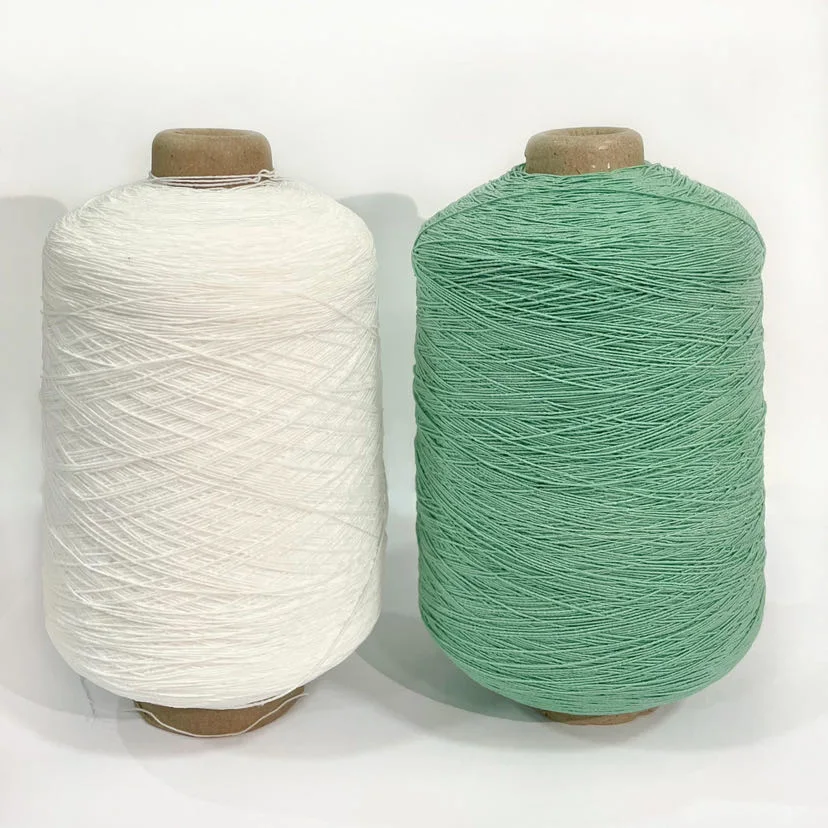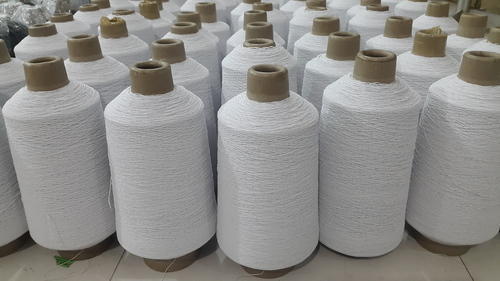Covered elastic yarn has revolutionized the textile industry, offering a perfect blend of stretch, durability, and versatility. This innovative material has found its way into countless applications, from comfortable everyday clothing to high-performance athletic wear. In this comprehensive article, we’ll delve into the world of covered elastic yarn, exploring its various types, properties, and the myriad benefits it brings to both manufacturers and consumers alike.
Covered Elastic Yarn

Covered elastic yarn is a specialized textile material that combines the elasticity of spandex or rubber with the strength and aesthetic appeal of a covering fiber. This unique construction allows for the creation of fabrics that possess both stretch and recovery properties while maintaining a soft, comfortable feel against the skin.
The Composition of Covered Elastic Yarn
Covered elastic yarn consists of two main components: a core and a covering. The core is typically made of elastic fibers such as spandex or rubber, which provide the stretch and recovery properties. The covering, on the other hand, is usually composed of non-elastic fibers like polyester, nylon, or cotton.
This combination of materials results in a yarn that can stretch and return to its original shape without losing its structural integrity. The covering fiber not only enhances the yarn’s appearance but also protects the elastic core from damage and wear.
Manufacturing Process
The production of covered elastic yarn involves a specialized process known as covering. In this technique, the elastic core is fed through a machine that wraps it with the covering fiber. This can be done in two ways: single covering or double covering.
Single covering involves wrapping the elastic core with a single layer of covering fiber. This method is simpler and more cost-effective but may result in a yarn with slightly less stability and durability.
Double covering, on the other hand, involves wrapping the elastic core twice, often in opposite directions. This method produces a more stable and durable yarn, with better recovery properties and a smoother appearance.
Applications of Covered Elastic Yarn
The versatility of covered elastic yarn has led to its widespread use across various industries. In the fashion and apparel sector, it’s commonly used in the production of form-fitting garments, activewear, and lingerie. The medical field utilizes covered elastic yarn in the manufacture of compression garments and bandages.
In the automotive industry, covered elastic yarn finds application in seat covers and other interior components that require both stretch and durability. The sports and leisure sector also benefits from this material, incorporating it into equipment like tennis racket strings and exercise bands.
Benefits of Using Covered Elastic Yarn
One of the primary advantages of covered elastic yarn is its ability to provide stretch and recovery without compromising on comfort or appearance. This allows for the creation of garments that move with the body, providing both freedom of movement and a flattering fit.
Durability is another key benefit. The covering fiber protects the elastic core from damage, extending the lifespan of the yarn and the products made from it. This results in clothing and other items that maintain their shape and elasticity even after repeated use and washing.
Furthermore, covered elastic yarn offers excellent color retention and dyeability. The covering fiber can be dyed to match any desired color, allowing for greater design flexibility and aesthetic appeal in the final product.
Lycra Covered Yarn

Lycra covered yarn, a specific type of covered elastic yarn, has gained immense popularity in the textile industry due to its superior stretch and recovery properties. Lycra, a brand name for spandex fiber, was developed by DuPont in 1958 and has since become synonymous with elasticity in fabrics.
The Unique Properties of Lycra
Lycra, also known as elastane, is a synthetic fiber known for its exceptional elasticity. It can stretch up to 500% of its original length and snap back to size without losing its shape. This remarkable property is what makes Lycra covered yarn so desirable in various applications.
When Lycra is used as the core in covered elastic yarn, it imparts these stretch and recovery properties to the final product. The result is a yarn that can create fabrics with excellent fit, comfort, and shape retention.
Manufacturing Lycra Covered Yarn
The process of manufacturing Lycra covered yarn is similar to that of other covered elastic yarns. The Lycra fiber forms the core, which is then wrapped with a covering fiber. The choice of covering fiber can vary depending on the desired properties of the final yarn.
Common covering fibers used with Lycra include polyester, nylon, and cotton. Each of these fibers brings its own unique characteristics to the yarn. For example, polyester offers durability and quick-drying properties, nylon provides strength and abrasion resistance, while cotton adds softness and breathability.
Applications in the Fashion Industry
Lycra covered yarn has found extensive use in the fashion industry, particularly in the production of form-fitting and stretchy garments. Its ability to provide a snug fit without restricting movement makes it ideal for activewear, swimwear, and lingerie.
In denim manufacturing, Lycra covered yarn has revolutionized the concept of stretch jeans. By incorporating this yarn into denim fabric, manufacturers can create jeans that offer both comfort and style, moving away from the rigid, uncomfortable jeans of the past.
The use of Lycra covered yarn in hosiery has also been transformative. It allows for the production of stockings and tights that fit well, maintain their shape, and provide a smooth, sleek appearance.
Performance Benefits of Lycra Covered Yarn
One of the key advantages of Lycra covered yarn is its superior recovery properties. Garments made with this yarn can stretch to accommodate movement and then return to their original shape, maintaining a neat appearance throughout wear.
Lycra covered yarn also contributes to the longevity of garments. Its ability to maintain shape and elasticity even after repeated stretching and washing means that clothes retain their fit and appearance for longer, providing better value for consumers.
Moreover, the incorporation of Lycra covered yarn can enhance the comfort of garments. Its stretch properties allow for greater freedom of movement, while its ability to conform to the body’s shape can provide a more flattering fit.
Covered Spandex Yarn
Covered spandex yarn, another popular variant of covered elastic yarn, shares many similarities with Lycra covered yarn. In fact, spandex is the generic term for the elastic fiber that Lycra is a brand name for. This type of yarn combines the exceptional stretch properties of spandex with the strength and aesthetic appeal of various covering fibers.
Understanding Spandex
Spandex, derived from the word “expands,” is a synthetic fiber known for its extraordinary elasticity. Like Lycra, it can stretch up to 500% of its original length and return to its initial size without losing its shape. This makes spandex an ideal core material for covered elastic yarn.
The development of spandex in the late 1950s marked a significant advancement in textile technology. Its ability to provide stretch and recovery properties superior to natural rubber revolutionized the production of form-fitting garments and other elastic products.
The Production Process of Covered Spandex Yarn
The manufacturing process for covered spandex yarn involves wrapping a spandex core with one or more layers of covering fiber. This can be done through single covering or double covering methods, similar to other types of covered elastic yarn.
In single covering, the spandex core is wrapped with a single layer of covering fiber. This method is more economical but may result in a yarn with slightly less stability. Double covering involves wrapping the spandex core twice, often in opposite directions, resulting in a more stable and durable yarn.
The choice of covering fiber can significantly influence the properties of the final yarn. Common options include polyester, nylon, cotton, and various blends. Each brings its own set of characteristics to the yarn, allowing manufacturers to create products tailored to specific needs.
Versatility in Application
Covered spandex yarn finds application in a wide range of products due to its versatility. In the clothing industry, it’s used extensively in the production of form-fitting garments such as leggings, yoga pants, and compression wear.
The medical field also benefits from covered spandex yarn, using it in the manufacture of compression garments and bandages. These products help in managing various medical conditions by providing controlled pressure to specific parts of the body.
In the sports industry, covered spandex yarn is used in the production of high-performance athletic wear. Its ability to provide both stretch and support makes it ideal for garments that need to move with the athlete while maintaining their shape.
Advantages of Using Covered Spandex Yarn
One of the primary benefits of covered spandex yarn is its ability to provide excellent stretch and recovery properties. This allows for the creation of garments that can conform to the body’s shape and movement, providing both comfort and a flattering fit.
Durability is another key advantage. The covering fiber protects the spandex core from damage, extending the lifespan of the yarn and the products made from it. This results in clothing and other items that maintain their shape and elasticity even after repeated use and washing.
Moreover, covered spandex yarn offers great design flexibility. The covering fiber can be dyed to match any desired color, allowing for greater aesthetic appeal in the final product. This makes it possible to create fashionable, colorful garments that don’t compromise on stretch or comfort.
Conclusion
Covered elastic yarn, whether it’s Lycra covered yarn or covered spandex yarn, has undoubtedly transformed the textile industry. Its unique combination of stretch, recovery, durability, and versatility has opened up new possibilities in garment design and manufacturing.
From everyday clothing to specialized medical garments, from high-performance athletic wear to comfortable lingerie, covered elastic yarn has found its place in numerous applications. Its ability to provide both function and form makes it a valuable material in today’s fast-paced, style-conscious world.
As textile technology continues to advance, we can expect to see even more innovative uses for covered elastic yarn. Whether it’s through new manufacturing techniques, novel fiber combinations, or groundbreaking applications, this versatile material is sure to remain at the forefront of textile innovation.
The benefits of using covered elastic yarn extend beyond just the end consumer. Manufacturers benefit from its ease of use and versatility, while designers appreciate the freedom it provides in creating form-fitting, comfortable garments. As we continue to demand more from our textiles – in terms of performance, comfort, and style – covered elastic yarn will undoubtedly play a crucial role in meeting these evolving needs.
